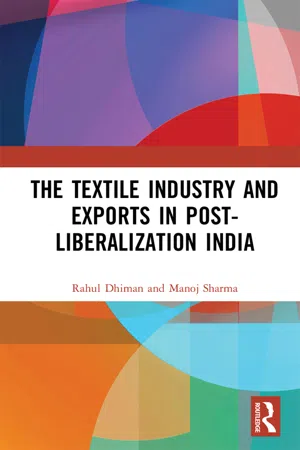
- 152 pages
- English
- ePUB (mobile friendly)
- Available on iOS & Android
The Textile Industry and Exports in Post-Liberalization India
About this book
This book is a comprehensive examination of the Indian textile industry and the various determinants affecting its export performance, trends in labour, and capital productivity in the post-liberalization years. Employing 45 million people, including skilled and unskilled workers, the Indian textile and clothing industry occupies a significant position in the Indian economy in terms of industrial production, employment, and exports.
This work traces the growth and expansion of this industry in the post-reform period and studies its contributions to the economic development of the nation. It discusses global trade agreements, India's share in international exports, and its major trading partners across the globe including the USA, UK, UAE, Germany, China. It also provides recommendations to Indian policy makers for a possible improvement in the textile exports across the globe.
The Textile Industry and Exports in Post-Liberalization India will be of interest to students and researchers of politics and international relations, economics, development studies, labour economics, sociology and social policy, and South Asian studies.
Frequently asked questions
- Essential is ideal for learners and professionals who enjoy exploring a wide range of subjects. Access the Essential Library with 800,000+ trusted titles and best-sellers across business, personal growth, and the humanities. Includes unlimited reading time and Standard Read Aloud voice.
- Complete: Perfect for advanced learners and researchers needing full, unrestricted access. Unlock 1.4M+ books across hundreds of subjects, including academic and specialized titles. The Complete Plan also includes advanced features like Premium Read Aloud and Research Assistant.
Please note we cannot support devices running on iOS 13 and Android 7 or earlier. Learn more about using the app.
Information
1 An introductory note about the Indian textile and clothing industry
Introduction
Historical overview of the Indian textile industry
- The management of raw materials, i.e. manufacturing fibres like cotton, flax, silk, wool, jute, etc. Man-made fibres comprise a variety of textile fibres and production of yarns through spinning. The natural cellulosic fibres, synthetic fibres, and fibres from inorganic materials such as carbon, glass, and metal.
- The activities related to knitting and weaving.
- The finishing actions for the purpose of providing fabrics the visual and physical properties to meet the demands of consumers such as bleaching, printing, dyeing, impregnating, etc.
- The last activity converts these fabrics into finished products, such as clothing products, carpets and other textile floor coverings, common household textile products such as kitchen linen, bed linen, toilet linen, curtains, etc.
Table of contents
- Cover
- Half Title
- Title
- Copyright
- Contents
- List of figures
- List of tables
- Preface
- Acknowledgements
- List of abbreviations
- 1 An introductory note about the Indian textile and clothing industry
- 2 Conceptual outline
- 3 Export performance and direction of textile exports
- 4 Determinants of export competitiveness
- 5 Summing up and policy implications
- Appendix 1
- Index